


Framed or unframed, desk size to sofa size, printed by us in Arizona and Alabama since 2007. Explore now.
Shorpy is funded by you. Patreon contributors get an ad-free experience.
Learn more.

- Yellow sky at morning
- Side Winder
- Air Quality?
- Sojourner Truth riot
- None were so blind(ed)
- The less famous sister
- Good ol' days?
- Rise and Fall
- Goo Goo Ga Joob
- Ticket Retention
- Not the only one
- Vagaries of War
- Killed by Amtrak
- Back to the Future
- Wanted --
- If you can't stand the light
- Centralized Traffic Control, I believe
- What's really happening
- Heckuva remote control!
- Sometimes — Things Go Bump!
- I SEE THE LIGHT
- Union Switch and Signal Company
- Get That Light Out Of My Eyes
- Eggs. Eggs. Eggs. The Egg Man is Here!
- Foreboding caption
- Famous Hollywood faces
- Not just S&P
- re: Those things in the jar
- Up In Smoke
- Medical Smoking
Print Emporium
Salvation Army: 1920
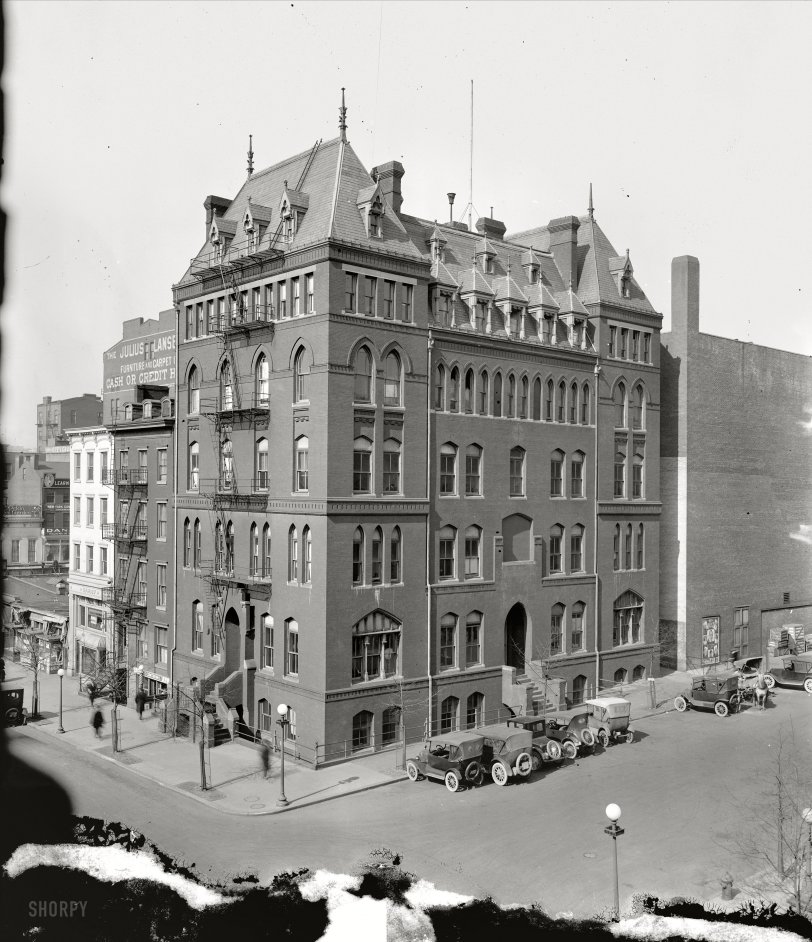
Washington, D.C, circa 1920. "Salvation Army." At the intersection of E and Eighth streets N.W. Harris & Ewing Collection glass negative. View full size.
Steam exhaust head
The funnel-thing on the roof looks like a steam exhaust head. Steam rises from the center pipe and there are baffles inside that create a vortex to extract condensed water with centrifugal force. Which is then collected from the exterior with the small pipe. This one seems to be a different design, though. And it beats the heck out of me why such thing is installed in the Salvation Army building, as steam heating systems doesn't need exhausts like this.
Faded glory
Here's the front of the Gayety (425-433 9th Street N.W.) in 1970, three years before it was razed:
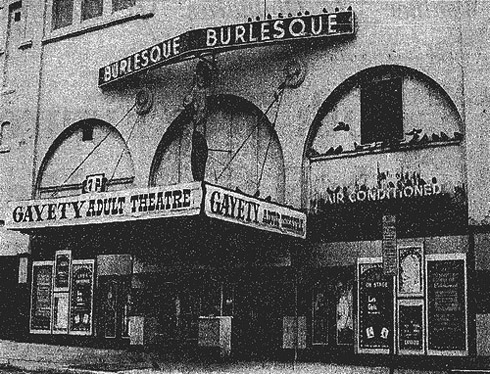
Impulse buy?
I've seen this in other Shorpy pix and thought it curious (no, I'm not going to search the archives for examples): ground floor shop selling COAL. You're walking down the street looking in the windows; a display catches your eye; "oh there's some lovely nuggets" escapes your lips, and before you know it you're inside contracting for a couple of tons to be delivered. Was the competition so fierce they needed such a visible presence?
[That's the office of Marlow Coal Co. Most cookstoves and furnaces were fueled by coal -- it was a big business. - Dave]
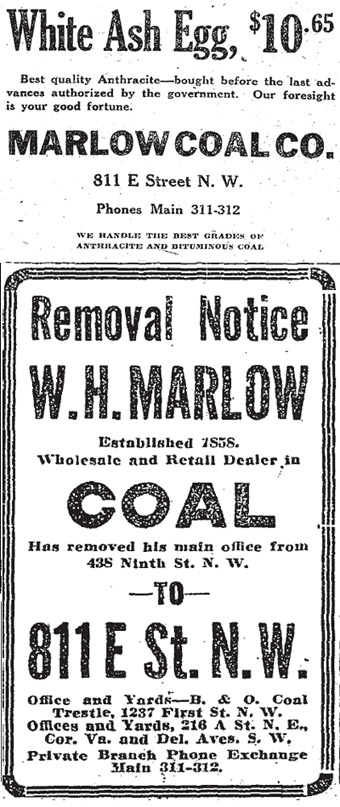
Pekin Tea Garden
Pekin Restaurant Opening
To the accompaniment of lively orchestral music, and garnished attractively throughout by lavish displays of brilliant flowers and intermingled American and Chinese flags, the Pekin Tea Garden, 502-4 Ninth street, yesterday opened its doors to an appreciative patronage that taxed to capacity the facilities of this latest mark of the enterprise of Der Doo, long favorably known to Washington's dining public through this Mandarin and Far East restaurants.
The Pekin Tea Garden is equipped with a spacious main dining room on the first floor, with additional large dining rooms and almost a score of private dining rooms and banquet rooms open to reservation on the floors above. The American-Chinese cuisine, excellent courtesy and promptness of service, together with the modern, sanitarily equipped kitchen, with electrical cooking devices - which many of the opening day guests found opportunity to inspect, made an impression highly gratifying to Mr. Der Doo and to the manager, Paul Der Yuen, and one that insures the permanent popularity of the Pekin Tea Garden in now cosmopolitan Washington. All opening day visitors were the recipients of flowers and souvenirs.
Advertisement, Washington Post, Sep 20, 1918
Pull
To put a horse in reverse, just pull back on the reins. The secret to handling a horse is that they move away from pressure.
Civil Service Bldg.
This building on the northwest corner of Eighth and E streets was originally occupied by the U.S. Civil Service Commission. The Salvation Army purchased it in 1920 for use as a women's dormitory. The fire escapes were not part of the original design.
Civil Service Commission to have New Fire Escapes
As a result of the passage of the law requiring fire escapes on all buildings in the District over three stories in height, except those occupied as private dwellings, John C. Black, president of the United States Civil Service Commission, has taken the preliminary steps toward complying with this new law as far as the commission's building at Eighth and E streets northwest is concerned.
...Washington Post, Apr 25, 1906
Thanks, but I'll take my chances with the fire
Just looking at the path you'd have to take on that fire escape from the middle of the building makes me dizzy. First, up at a 45 or 50-degree slope to the peak of the roof (don't look down). Then DOWN at the same angle to the first landing (eyes shut might help). Then down to four more landings before arriving at the Terrifying Counterweighted Sliding Ladder. Which must be at least 20 feet above the street. I'll bet they didn't have many fire drills.

Roof-Thing
What's the funnel-shaped thing on the pole in the center of the roof?
[Rusty. - Dave]

Fear of flames. And heights.
Yikes. That fire-escape ladder goes over the TOP of the roof! Talk about scary.
Blank Wall
Based on the Baist realty maps of the time, the large blank wall is the rear wall of the Gayety Theater - the front entrance was on Ninth street.
The Ben Welch Big Show
Washington Post, Feb. 15, 1920.
Gayety -- Ben Welch.Ben Welch, who takes rank among the foremost comedians allied with the burlesque stage, will bring "The Ben Welch Big Show" to the Gayety Theater this afternoon as the attraction for one week. The entertainment this year is divided into three burlettas: "The Love Arbor," "Izzy at the Movies" and "Izzy at the Cabaret," in all of which the chief comedy roles are portrayed by Welch. The supporting cast includes Pat Kearney, Frank P. Murphy and Dolly Morrissey.
A million details
Of all the fascinating little details in this image, the one that intrigues me most is the guy who seems to be ducking between two stacks of crates on the far right. What the heck is he doing?
Guy Noir
On the fourth floor of the Acme building, one man is still trying to find the answer to life's persistent questions... Guy Noir, Private Eye.
Horse parking protocol
Incredible gothic windows -- you can see several men sitting at their desks. One has taped a newspaper up to the glass (perhaps to keep the sun out of his eyes. I guess they didn't get curtains, blinds, or shades in his office).
There are two license plates on several of the cars -- each jurisdiction required its own registration, so if you lived in Virginia but worked in D.C., you had to register your car in both places. Interstate trucks still have to do that, but thankfully they don't have to wear 40 license plates today. They just get a form from each state, and the word "apportioned" on their home base plate.
All of the cars are so different from each other in size and proportion. And there is one lone holdout against those newfangled auto-mobiles.
All the cars went front-in to their parking space, but the horse seems to park tail-in. Makes me wonder if there was some logic to that. One would think that the horse would be happier the other way because you could leave him some food and water on the sidewalk. It would also make for less equine byproduct to step in, right at the curb, if you know what I mean.
But for some reason his driver didn't think that way.
[I'd imagine it was because he had freight to unload. What I want to know is, how do you put a horse in reverse? - Dave]
Ben Welch
There's an interesting story associated with the vaudeville star of the "Big Show" on that poster on the right. Ben Welch went blind in the '20s and continued his stage act anyway.
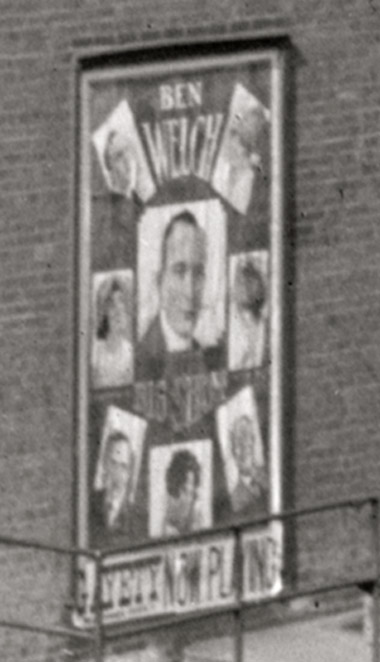
Another winner
Wonderful entry steps on the left side! But what is that blank structure to the right? I'd presume it's a warehouse of some sort. I see the Lansburgh sign in the left background; another classic store that is now gone. So many of these photographs remind us of what we are missing and what "modern" generations will never get a chance to experience.
























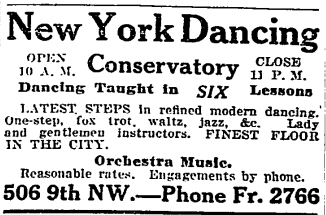
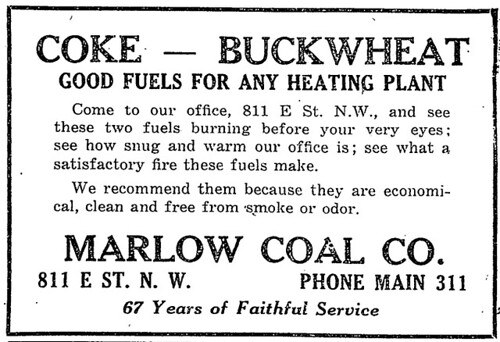
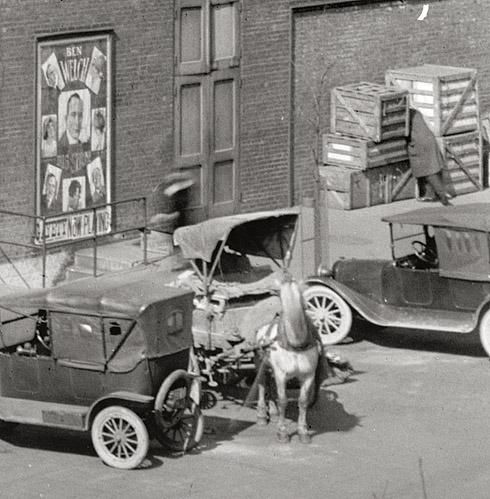
On Shorpy:
Today’s Top 5